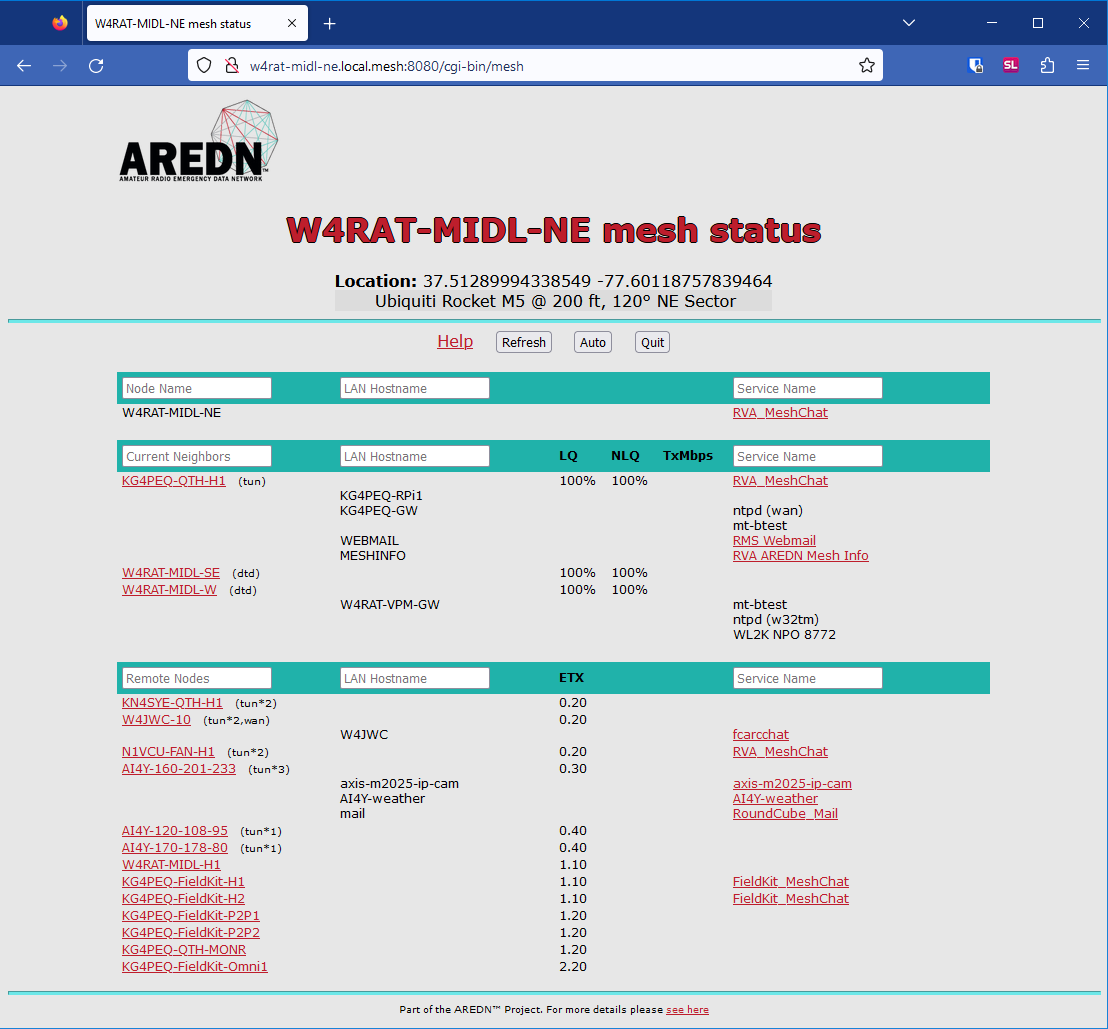|
What is AREDN?
AREDN is the next generation of amateur radio data. In the past, ham radio "data" communications for the most part meant AX.25 based packet radio or APRS, operating in very short and relatively infrequent bursts of usually 1200 bps data. D-STAR offers data speeds up to 128 kbps, but only on the 1.2 GHz band, and only with a single radio which has been discontinued by the manufacturer.
AREDN combines WISP-grade Part 15 wireless radios and antennas, custom firmware, and the expanded operating privileges of Part 97, to produce a wireless mesh data network offering sustained data speeds of up to many megabits per second, over great distances and with significantly lower latency compared to conventional ham radio data modes. It operates with Internet-standard TCP/IP protocols, which allows many popular networked applications to be deployed within the mesh. AREDN uses familiar Internet applications like web browsers, e-mail clients, and chat software, but it is not a way to access the public Internet. Unlike most other ham radio digital modes, AREDN enables real-time audio and video streaming, video conferencing, large file transfers, and VoIP telephony. A wide variety of familiar applications and services can be provided.
 As a mesh network, stations can come and go dynamically. Each station that joins the mesh has an opportunity to extend and add density to the network. A single directional antenna and radio connects the user to a nearby node. A second antenna and radio will further extend the reach of the network, or might be pointed at a second nearby node for an additional route to the network. Traffic is intelligently routed around congested segments of the network, so the more nodes we have, the more routing options there are, which improves the capacity and reliability of the network.
As a mesh network, stations can come and go dynamically. Each station that joins the mesh has an opportunity to extend and add density to the network. A single directional antenna and radio connects the user to a nearby node. A second antenna and radio will further extend the reach of the network, or might be pointed at a second nearby node for an additional route to the network. Traffic is intelligently routed around congested segments of the network, so the more nodes we have, the more routing options there are, which improves the capacity and reliability of the network.
AREDN operates at 900 MHz, 2.4 GHz, 3.2 GHz, and 5.8 GHz. For the typical home user, AREDN is faster, cheaper, and more energy efficient than any other digital mode available to ham radio operators today.
The image at the left is a screenshot of AREDN nodes connected to the network as of 9/23/2023 and the services they are providing to the network.
From the AREDN project web site:
In today’s high-tech society people have become accustomed to different ways of handling their communication needs. The preferred methods involve short messaging and keyboard-to-keyboard communication, along with audio-video communication using Voice over IP (VoIP) and streaming technologies.
The amateur radio community is able to meet these high-bandwidth digital communication requirements by using FCC Part 97 amateur radio frequency bands to send digital data between devices which are linked with each other to form a self-healing, fault-tolerant data network. Some have described this as an amateur radio version of the Internet. Although it is not intended for connecting people to the Internet, an AREDN® mesh network will provide typical Internet or intranet-type applications to people who need to communicate across a wide area during an emergency or community event.
To connect to the AREDN network, a supported WiFi router or access point is reflashed with custom AREDN firmware and then aimed at another nearby node. AREDN nodes will automagically recognize each other and link up when in range. The AREDN firmware handles the routing of traffic to other nodes and services within the accessible portion of the network.
Learn More
The homepage for the local AREDN network build-out is RVA-AREDN.net, or http://MESHINFO/ from within the AREDN system.
What AREDN is NOT
AREDN is not a replacement for commercial Internet services, nor does it (normally) provide general Internet access. It's not a way to check your GMail or Yahoo mail, watch YouTube, browse CNN, stream SiriusXM, update Microsoft Windows, or post to your Facebook, Twitter, Mastodon, or OnlyHams feed. You may recognize many of the applications and web-based services that do work and might be hosted within the AREDN network, but they're (generally) not communicating with the public Internet. Only users within the mesh can access these services.
The AREDN network does not have the capacity to handle general-purpose, unrestricted Internet access, much of which would likely occur over encrypted protocols which are not permitted on a Part 97 network anyway. General-purpose Internet access is outside the scope and spirit of the AREDN network and the amateur service, and RATS WAN gateways will not normally provide this functionality.
RATS Participation in AREDN
In late 2019, RATS installed a 3-sector, 5 GHz AREDN mesh node at our repeater site in Chesterfield County. At the time, several other AREDN nodes were operating from sites in downtown Richmond, northwestern Hanover, and eastern Henrico County. This network made possible, for the first time in our area, the long-distance transport of data over amateur frequencies at broadband speeds with low latency. Testing from a privately-owned AREDN node south of Manchester, ping latency to the node in Beaverdam was frequently under 10 milliseconds round-trip.
The RATS AREDN project stalled between 2020 and 2022 and many of the
previous nodes are now offline, but the main 3-sector site in
Chesterfield County remains on the air and ready for other nodes to link
up. A group of local AREDN enthusiasts are working to restore service from one of the previous nodes in downtown Richmond. The group plans to continue earlier work on an AREDN backbone across the metro area, with an emphasis on service to the City of Richmond and the counties of Hanover, Henrico, Chesterfield, and New Kent. This backbone will provide several high-visibility sites to serve as easy targets for users with modest masts and rooftop antennas. Field deployable AREDN network kits are also being built, which can provide local network services for special events and emergency response activities, with or without access to the RVA AREDN backbone.
The current Chesterfield
node is situated 200 feet up our tower and represents a tremendous asset
to the amateur community. RATS will continue to operate and maintain the W4RAT-MIDL node in Chesterfield, and in the future the club may make additional investments in the technology.
Programming note: On August 26, 2023, the RATS AREDN nodes switched from 5 MHz to 10 MHz channels. This will be the standard channel width for the RVA AREDN system moving forward. This change has been made to accommodate newer radios which do not support legacy 5 MHz channels.
